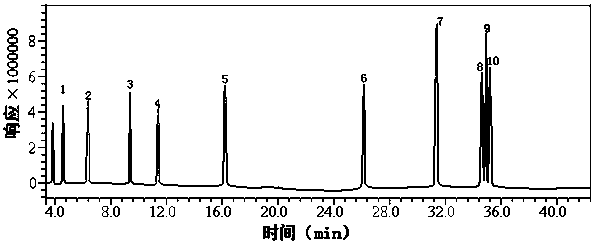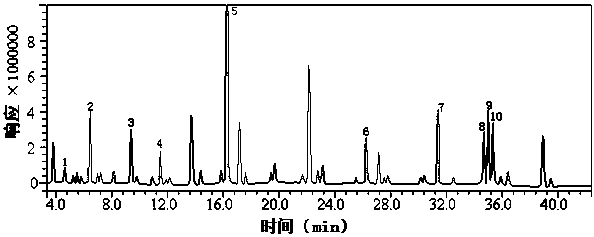Method for separating and assaying organic acid and fatty acid substances in saliva
A technology for organic acids and fatty acids, applied in the field of analytical chemistry, can solve problems such as no reports, and achieve the effects of simple pretreatment, low detection limit, and high methyl esterification efficiency.
- Summary
- Abstract
- Description
- Claims
- Application Information
AI Technical Summary
Problems solved by technology
Method used
Image
Examples
Embodiment 1
[0041] A method for separating and measuring organic acids and fatty acid substances in the saliva of tobacco smokers, comprising the following steps:
[0042]Step (1), sample collection: put 0.2 g of absorbent cotton in the mouth of tobacco smokers, leave it for 0.3 min, take it out, put it in the syringe barrel, push and squeeze it with the syringe push rod, and collect the extruded liquid in a centrifuge tube, Saliva samples were obtained by centrifugation at 10000 rpm for 10 min.
[0043] Step (2), salting-out extraction: Pipette 2.0 mL of saliva sample into a centrifuge tube, add 2.0 mL of methanol, 1 g of anhydrous magnesium sulfate, 0.2 g of sodium chloride, 0.2 g of sodium citrate, 0.1 g of dihydrogen citrate Sodium, vortex at 500 rpm for 2.0 min, then centrifuge at 10000 rpm for 5 min, and take the extract layer;
[0044] Step (3), methyl esterification: Add sulfuric acid with 10% volume of the extract to the extract, move it into a microwave extraction tank and seal...
Embodiment 2
[0052] A method for separating and measuring organic acids and fatty acid substances in the saliva of liquor drinkers, comprising the following steps:
[0053] Step (1), sample collection: 1.5 g of absorbent cotton was placed in the mouth of tobacco smokers for 4.0 min, then taken out, placed in the syringe barrel, pushed and squeezed with the syringe push rod, the extruded liquid was collected in a centrifuge tube, Saliva samples were obtained by centrifugation at 15000 rpm for 12 min.
[0054] Step (2), salting-out extraction: pipette 8.0 mL of saliva sample into a centrifuge tube, add 8.0 mL of methanol, 5 g of anhydrous sodium sulfate, 0.8 g of sodium chloride, 10 μL of formic acid, and vortex at 15000 rpm for 10.0 min, then centrifuge at 10000 rpm for 5 min, and take the extract layer;
[0055] Step (3), methyl esterification: add boron trifluoride with 30% volume of the extract to the extract, and carry out methyl esterification reaction at 75°C in a water bath for 5 mi...
Embodiment 3
[0062] A method for separating and measuring organic acids and fatty acid substances in saliva, comprising the following steps:
[0063] Step (1), sample collection: put 0.2 g of absorbent cotton in the mouth for 0.2 min, then take out the absorbent cotton that has absorbed saliva, put it in the syringe barrel, push and squeeze it with the syringe push rod, and collect the extruded liquid in a centrifuge tube In the process, after high-speed centrifugation, collect the supernatant to obtain a saliva sample; the centrifugation speed of saliva should not be lower than 10,000 rpm, and the centrifugation time should not be less than 10 min;
[0064] Step (2), salting-out extraction: pipette 0.5 mL of saliva sample into a centrifuge tube, add methanol, sodium chloride, extraction salt and pH regulator, vortex until well mixed, and then centrifuge, take the extraction solution containing methanol liquid layer to obtain the first extract; wherein, the vortex oscillation speed is 100 ...
PUM
| Property | Measurement | Unit |
|---|---|---|
| Quality | aaaaa | aaaaa |
Abstract
Description
Claims
Application Information
 Login to View More
Login to View More - R&D
- Intellectual Property
- Life Sciences
- Materials
- Tech Scout
- Unparalleled Data Quality
- Higher Quality Content
- 60% Fewer Hallucinations
Browse by: Latest US Patents, China's latest patents, Technical Efficacy Thesaurus, Application Domain, Technology Topic, Popular Technical Reports.
© 2025 PatSnap. All rights reserved.Legal|Privacy policy|Modern Slavery Act Transparency Statement|Sitemap|About US| Contact US: help@patsnap.com



